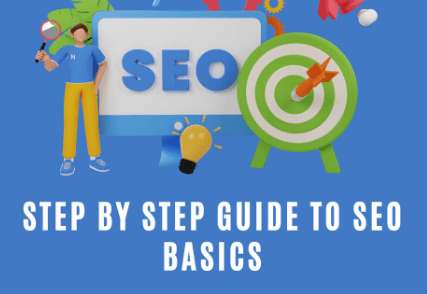
SEO for New Websites: A Step-by-Step Guide to Getting Started
The advanced world is endless and developing by the moment. As modern websites spring up in each corner of the web, each points to carve out its one of a kind space and pull in guests. In any case, with millions of websites competing for consideration, how can a unused site guarantee it doesn’t get misplaced within the swarm? The reply lies in Look Motor Optimization (SEO). Whether you’re driving a singular web diary, an internet business store, or a corporate area, understanding and completing Web optimization is fundamental to your internet based triumph. This direct will walk you through the basic steps to induce your SEO procedure off the ground and set your site up for long-term perceivability and development.
Understanding SEO: The Foundation of Online Visibility
Some time recently jumping into the specifics of optimizing your site, it’s significant to get it what SEO really is. Website design enhancement represents Look Engine Streamlining, which alludes to the strategy for updating your webpage to make it more clear in look engine occurs. The essential objective of SEO is to pull in natural, or unpaid, activity by showing up higher on look motor result pages (SERPs).
Outsource SEO When a potential guest sorts a inquiry into a look motor like Google, the look motor employments complex calculations to decide which websites best coordinate that inquiry. These calculations consider various components, counting the significance of the substance, the quality of the site, client involvement, and indeed the website’s speed. By optimizing these components, you increment the probability of your location showing up on the primary page of comes about, where most clients discover their answers. Understanding this establishment permits you to see SEO not fair as a set of strategies but as a key approach to making your site stand out.
Conducting Thorough Keyword Research: The Cornerstone of SEO
Keyword inquire about is the primary and most basic step in any SEO methodology. Catchphrases are the expressions and terms that potential guests utilize when searching for substance online. By distinguishing and focusing on the correct watchwords, you’ll adjust your website’s substance with what your group of onlookers is effectively looking for. This arrangement increments the chances of your location showing up in pertinent look comes about, in this manner driving focused on activity to your location.
To conduct successful watchword inquire about, begin by conceptualizing a list of words and expressions related to your website’s substance, items, or administrations. At that point, utilize watchword investigate instruments like Google Watchword Organizer, Ahrefs, or SEMrush to grow your list and accumulate information on the look volume and competition level of each catchphrase. The objective is to distinguish catchphrases that have a great adjust between tall look volume and moo competition. These “sweet spot” watchwords are more likely to bring in activity without confronting as well much competition from built up websites.
Once you’ve distinguished your target watchwords, coordinated them normally into your website’s substance, counting titles, headings, meta portrayals, and body content. Keep in mind, watchword stuffing (over-burdening your substance with catchphrases) can hurt your SEO endeavors, so center on making high-quality substance that gives esteem to your guests whereas consolidating catchphrases naturally.
Crafting High-Quality Content: The Heart of SEO Success
Substance is the soul of any site, and within the world of SEO, quality substance rules preeminent. Look motors prioritize websites that offer important, instructive, and significant substance to clients. Subsequently, making high-quality substance ought to be at the center of your SEO technique.For guidance on optimizing your content effectively, consider working with an SEO advisor.
What questions do they have? What problems are they attempting to fathom? Once you’ve got a clear understanding, make substance that addresses these needs in a comprehensive and locks in way. Whether you’re composing web journal posts, item depictions, or landing page duplicate, guarantee your substance is well-researched, instructive, and free of mistakes.
In expansion to content, consider joining other shapes of substance, such as recordings, infographics, and podcasts. These can improve the client encounter and make your substance more shareable, which can lead to more backlinks (a pivotal figure in SEO). At long last, guarantee your substance is routinely upgraded to keep it significant and new, as look motors favor destinations that are effectively kept up.
On-Page Optimization: Fine-Tuning the Details for Maximum Impact
On-page SEO alludes to the optimization of person pages on your site to make strides their look motor positioning and pull in more pertinent activity. This incorporates both the substance on the page and the HTML source code.
Start with the basics, such as optimizing your title tags and meta descriptions. Both should be compelling and include your target keywords to encourage users to click through to your site.
Next, focus on your headings (H1, H2, H3, etc.). Headings help structure your content and make it easier for both users and search engines to understand the main topics of your page. Include your keywords in your headings where appropriate, but ensure they flow naturally within the content.
Another crucial aspect of on-page optimization is ensuring your site is mobile-friendly. With more users accessing the internet via mobile devices, search engines have made mobile usability a significant ranking factor. Use responsive design techniques to ensure your site looks and functions well on all screen sizes.
Technical SEO: Ensuring Your Website is Search Engine Friendly
While content and on-page optimization are vital, they won’t be as effective if search engines can’t properly crawl and index your website. This is where technical SEO comes into play. Technical SEO involves optimizing your website’s infrastructure to ensure that search engines can access, crawl, interpret, and index your site without any issues.
One of the first steps in technical SEO is ensuring your website has a clean and organized structure. This includes creating a clear hierarchy with categories, subcategories, and internal linking that makes it easy for both users and search engines to navigate your site. A well-structured website not only improves user experience but also helps search engines understand the relationship between different pages and the importance of each page.
Additionally, you need to focus on website speed. Page load time is a critical ranking factor, and a slow website can frustrate users and lead to higher bounce rates. Use tools like Google PageSpeed Insights to identify and fix any issues that may be slowing down your site, such as large image files, inefficient code, or too many plugins.
Another key component of technical SEO is ensuring your site is secure. Websites with HTTPS (as opposed to HTTP) are favored by search engines because they provide a secure connection, which protects users’ data. Ensure your site has an SSL certificate to enable HTTPS and protect your visitors’ information.
Building High-Quality Backlinks: Earning Authority and Trust
Backlinks, or inbound links from other websites to yours, are a significant factor in determining your site’s authority and ranking potential. When reputable websites link to your content, search engines view this as a vote of confidence, which can improve your site’s ranking.
Building high-quality backlinks is a long-term strategy that involves creating content worth linking to and actively seeking out opportunities to earn links. Start by reaching out to websites in your industry and offering to write guest posts or collaborate on content that includes a link back to your site. You can also engage in online communities and forums where you can share your expertise and link back to relevant content on your site.
Remember, not all backlinks are created equal. Focus on earning links from reputable and relevant websites, as low-quality or spammy links can harm your SEO efforts.
Monitoring and Adjusting Your SEO Strategy: The Key to Ongoing Success
SEO is not a one-time effort but an ongoing process that requires constant monitoring and adjustment. As search engines update their algorithms and competitors refine their strategies, it’s essential to stay on top of your SEO efforts to maintain and improve your rankings.
Use tools like Google Analytics and Google Search Console to track your site’s performance, including traffic, bounce rates, and keyword rankings. These insights will help you identify what’s working and what needs improvement.
Additionally, keep an eye on industry trends and algorithm updates to ensure your SEO strategy remains current and effective. Regularly review and update your content, on-page optimization, and technical SEO to ensure your site continues to perform well in search engine results.
Conclusion: Setting Your New Website Up for Long-Term Success
Launching a new website is an exciting venture, but it comes with its challenges, especially in the competitive online space. By implementing a solid SEO strategy from the start, you can set your website up for long-term success. Remember, SEO is a marathon, not a sprint. It takes time to see results, but with consistent effort, your website can achieve higher rankings, attract more traffic, and ultimately reach its goals. As you embark on this journey, keep this step-by-step guide in mind, and you’ll be well on your way to mastering SEO for your new website.




